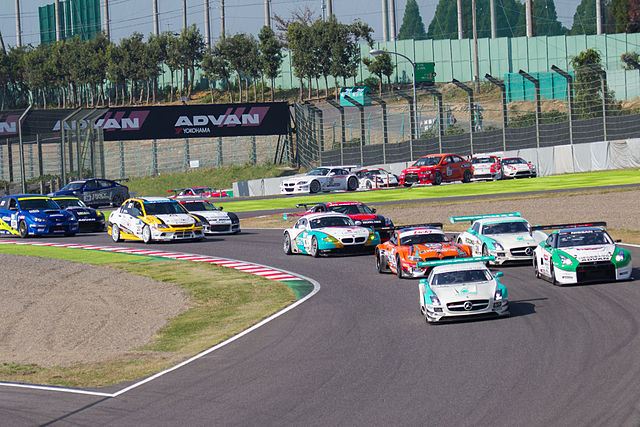Top Qs
Timeline
Chat
Perspective
Super Taikyu Series
Auto racing championship in Japan From Wikipedia, the free encyclopedia
Remove ads
Super Taikyu (スーパー耐久, Super Endurance), formerly known as the Super N1 Taikyu Series prior to 2005 and N1 Endurance Series prior to 1995, and currently named the Eneos Super Taikyu Series Empowered by Bridgestone for sponsorship reasons, is a Japanese endurance racing series that began in 1991. In contrast to the Super GT series, Super Taikyu is a pro-am racing series for commercially available racing vehicles such as GT3, GT4, and TCR cars, and minimally modified production vehicles mainly from the Japanese domestic market.

Super Taikyu races are held across all of Japan's major motor racing circuits, with formats including a single five-hour race, and a double-header format of two three-hour races. The series' largest event is the Fuji Super TEC 24 Hours, which is held annually at Fuji Speedway since its revival in 2018. Prior to that, the Tokachi 24 Hours was the series' largest event, held annually from 1994 until 2008.
In 2022, Eneos became the new title sponsor of the series.[1]
Remove ads
Classes
Summarize
Perspective
The series has five domestic classes of vehicles originally based on the FIA Group N regulations and four international classes, two based on SRO Motorsports Group and one class each from regulations of WSC Group and ADAC.
The original Group N-based ST-1 to ST-4 classes are the four original classes, with a fifth production class, ST-5, launched in 2010. As is the case with the original Group N, displacement and drivetrain layouts distinguish theses classes.
In 2011, the series began adding cars from SRO Motorsports Group's internationally recognised Group GT3, originally called ST-GT3 but currently labeled as ST-X. In 2017, two other international classes, ST-Z for the SRO GT4 and ST-TCR for touring cars class homologated for the international TCR class. In 2021, the ADAC-based ST-Q was added.
ST-Q

In 2021, the ST-Q class was introduced for manufacturer-developed, non-homologated special racing vehicles, following with rules based on the ADAC NLS SP-X class.[2] Toyota and ROOKIE Racing entered a modified Corolla Sport (GR Corolla) hatchback, equipped with a hydrogen-powered internal combustion engine, in ST-Q beginning in 2021.[3] In the 2021 season finale, Mazda entered a modified version of their Demio (Mazda2) subcompact, powered by biofuel.[4]




In 2022, Toyota and Subaru entered special versions of their GR86 and BRZ sports cars, adapted to run on carbon-neutral synthetic fuel.[5] That same year, Nissan entered a "Racing Concept" version of their new Fairlady Z (RZ34) sports car, which served as the prototype for the Nissan Z GT4.[6] Mazda introduced a new biodiesel concept, the Mazda3 Bio Concept, at the end of 2022.[7]
The hydrogen GR Corolla will adopt the use of liquid hydrogen in 2023 - the first race car in the world to do so.[8] Honda introduced a carbon-neutral fuel compatible version of the Civic Type R in 2023.[9]
NOTE: GT3, GT4, and TCR classes require homologation be current. GT4 and TCR classes must have had an FIA member club approved Balance of Performance test.
Remove ads
Tyres
Yokohama was the series' official tyre supplier until the end of 2017. In 2018, Pirelli became the series' new tyre supplier as part of a three-year contract. In 2021, Hankook became the series' new tyre supplier. Their contract was to last for three years, ending in 2023, with the option to extend the contract through the end of the 2025 season.[11]
Due to the fire at Hankook's manufacturing plant in Daejeon on 12 March 2023, Bridgestone signed a new three-year contract to take over as the tyre supplier of Super Taikyu beginning in 2024. On 24 April, it was announced that Bridgestone would take over as the series' tyre supplier with immediate effect on 24 April, prior to the second round of the 2023 season.[12]
Remove ads
Champions
Summarize
Perspective
ST-X/GT3 Class (2011–present)
Bold drivers indicate a driver that entered scored every possible point for their respective teams. Drivers listed in italics competed in a select number of rounds for their respective team.
ST-Z/GT4 Class (2017–present)
Bold drivers indicate a driver that was entered in every race for their respective team. Drivers listed in italics competed in a select number of rounds for their respective team.
ST-TCR Class (2017–present)
ST-1 Class (1991–present)
Bold drivers indicate a driver that entered scored every possible point for their respective teams. Drivers listed in italics competed in a select number of rounds for their respective team.
ST-3 Class (1991–present)
Bold drivers indicate a driver that entered scored every possible point for their respective teams. Drivers listed in italics competed in a select number of rounds for their respective team.
Remove ads
Incidents
During a 2012 race at Suzuka Circuit (a support event for the 2012 FIA WTCC Race of Japan), Osamu Nakajima, driving a Nissan Fairlady Z (Z33), died after crashing into a barrier at the first corner of the circuit.[13]
References
External links
Wikiwand - on
Seamless Wikipedia browsing. On steroids.
Remove ads

